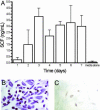Human airway epithelial cell determinants of survival and functional phenotype for primary human mast cells
- PMID: 16186496
- PMCID: PMC1242292
- DOI: 10.1073/pnas.0503948102
Human airway epithelial cell determinants of survival and functional phenotype for primary human mast cells
Abstract
Mast cells (MCs) are found in increased numbers at airway mucosal surfaces in asthmatic patients. Because human airway epithelial cells (HAECs) actively participate in airway inflammatory responses and are in direct contact with MCs in the mucosa, we hypothesized that HAEC-MC interactions may contribute to the differentiation and survival of MCs in the airway mucosa. Here, we show that HAECs express mRNA and protein for soluble and membrane-bound stem cell factor, releasing soluble stem cell factor into the cell culture supernatant at a concentration of 5.9 +/- 0.1 ng per 10(6) HAEC. HAECs were able to support MC survival in coculture in the absence of any exogenous cytokines for at least 4 d. Before the initiation of coculture, MCs were uniformly tryptase and chymase (MC(TC)) double positive, but by 2 d of coculture the majority of MCs expressed tryptase (MC(T)) alone. MCs supported in coculture generated low amounts of cysteinyl-leukotrienes (cys-LT) after FcepsilonRI-dependent activation (0.2 +/- 0.1 ng of cys-LT per 10(6) cells) and required priming with IL-4 and IL-3 during coculture to achieve a quantity of cys-LT generation within the range expected for human lung mucosal MC (26.5 +/- 16 ng of cys-LT per 10(6) cells). In these culture conditions, HAECs were able to direct mucosal MC protease phenotype, but T cell-derived Th2 cytokines were required for the expression of a functional airway MC eicosanoid phenotype. Thus, distinct cell types may direct unique aspects of reactive mucosal MC phenotype in the airways.
Figures







Similar articles
-
Human mast cells arise from a common circulating progenitor.J Allergy Clin Immunol. 2013 Aug;132(2):463-9.e3. doi: 10.1016/j.jaci.2013.02.011. Epub 2013 Apr 9. J Allergy Clin Immunol. 2013. PMID: 23582567
-
Mast cells expressing chymase but not tryptase can be derived by culturing human progenitors in conditioned medium obtained from a human mastocytosis cell strain with c-kit ligand.J Immunol. 1996 Jun 15;156(12):4839-44. J Immunol. 1996. PMID: 8648132
-
Detection of tryptase-, chymase+ cells in human CD34 bone marrow progenitors.Clin Exp Allergy. 2004 Nov;34(11):1719-24. doi: 10.1111/j.1365-2222.2004.02105.x. Clin Exp Allergy. 2004. PMID: 15544596
-
Mast Cell-Mediated Orchestration of the Immune Responses in Human Allergic Asthma: Current Insights.Clin Rev Allergy Immunol. 2019 Apr;56(2):234-247. doi: 10.1007/s12016-018-8720-1. Clin Rev Allergy Immunol. 2019. PMID: 30506113 Review.
-
Cytokines regulate development of human mast cells from hematopoietic progenitors.Int J Hematol. 2002 May;75(4):350-6. doi: 10.1007/BF02982123. Int J Hematol. 2002. PMID: 12041663 Review.
Cited by
-
Increased mast cell density and airway responses to allergic and non-allergic stimuli in a sheep model of chronic asthma.PLoS One. 2012;7(5):e37161. doi: 10.1371/journal.pone.0037161. Epub 2012 May 14. PLoS One. 2012. PMID: 22606346 Free PMC article.
-
Lung Function in African American Children with Asthma Is Associated with Novel Regulatory Variants of the KIT Ligand KITLG/SCF and Gene-By-Air-Pollution Interaction.Genetics. 2020 Jul;215(3):869-886. doi: 10.1534/genetics.120.303231. Epub 2020 Apr 23. Genetics. 2020. PMID: 32327564 Free PMC article.
-
Mast cell phenotype, location, and activation in severe asthma. Data from the Severe Asthma Research Program.Am J Respir Crit Care Med. 2011 Feb 1;183(3):299-309. doi: 10.1164/rccm.201002-0295OC. Epub 2010 Sep 2. Am J Respir Crit Care Med. 2011. PMID: 20813890 Free PMC article.
-
Rare Pulmonary Connective Tissue Type Mast Cells Regulate Lung Endothelial Cell Angiogenesis.Am J Pathol. 2020 Aug;190(8):1763-1773. doi: 10.1016/j.ajpath.2020.04.017. Epub 2020 May 22. Am J Pathol. 2020. PMID: 32450152 Free PMC article.
-
Glandular mast cells with distinct phenotype are highly elevated in chronic rhinosinusitis with nasal polyps.J Allergy Clin Immunol. 2012 Aug;130(2):410-20.e5. doi: 10.1016/j.jaci.2012.02.046. Epub 2012 Apr 24. J Allergy Clin Immunol. 2012. PMID: 22534535 Free PMC article.
References
-
- Davies, D. E. (2001) Curr. Allergy Asthma Rep. 1, 127-133. - PubMed
-
- Schulman, E. S., MacGlashan, D. W., Jr., Peters, S. P., Schleimer, R. P., Newball, H. H. & Lichtenstein, L. M. (1982) J. Immunol. 129, 2662-2667. - PubMed
-
- Bingham, C. O., III, & Austen, K. F. (2000) J. Allergy Clin. Immunol. 105, S527-S534. - PubMed
-
- Galli, S. J. (1990) Lab. Invest. 62, 5-33. - PubMed
-
- Austen, K. F. & Boyce, J. A. (2001) Leuk. Res. 25, 511-518. - PubMed
Publication types
MeSH terms
Substances
Grants and funding
LinkOut - more resources
Full Text Sources

